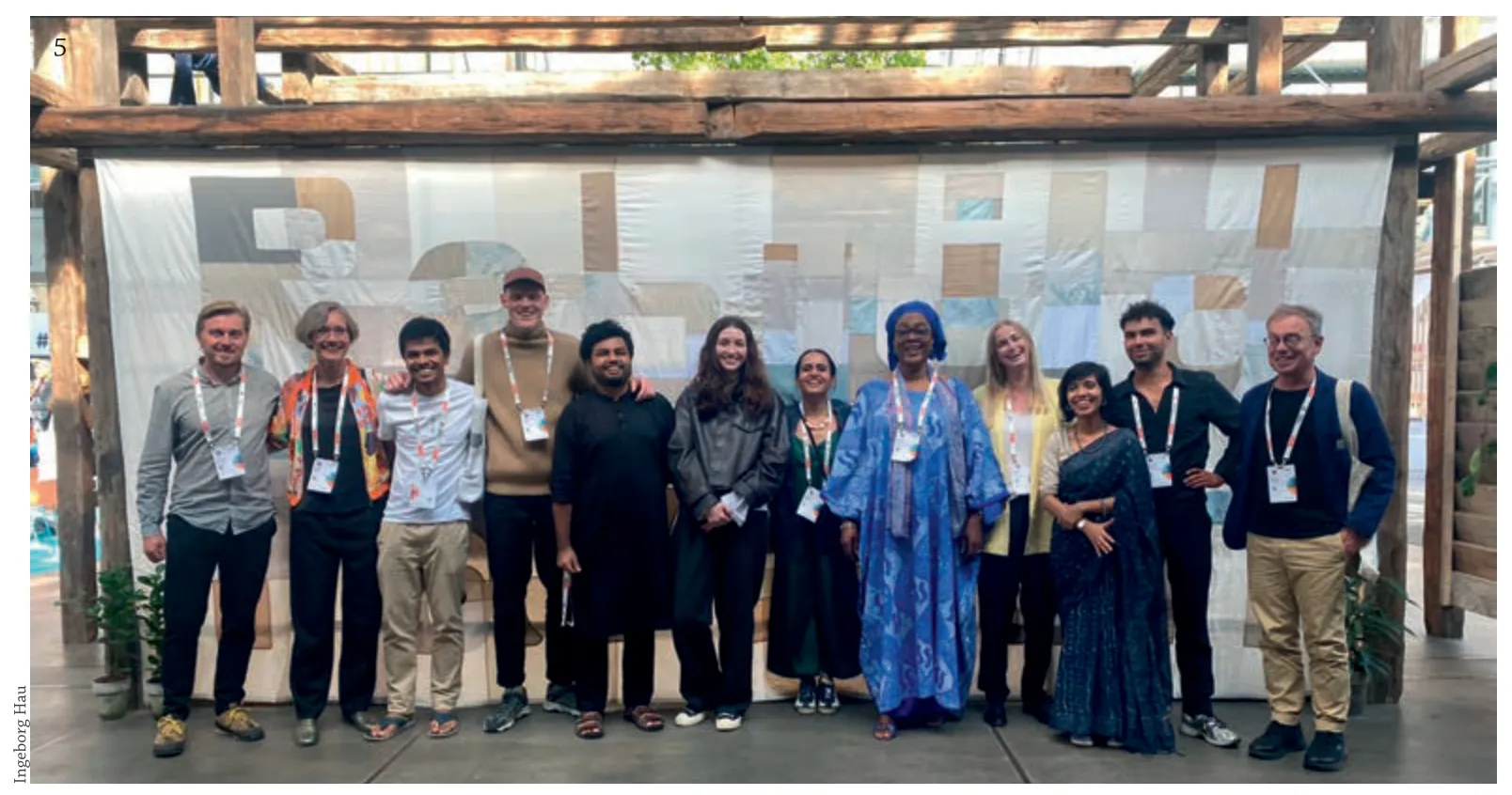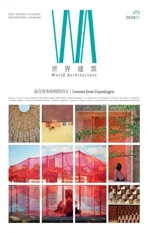重建可持续未来
——相互理解如何强化建筑对2030年议程的贡献
2024-01-27英格博格
英格博格·豪
将6000 名从事可持续建筑工作的专业人士聚集到哥本哈根是一项不小的投入。这不仅需要大量时间来策划,还要求每位参与者投入时间、精力和财力,更不用说整个项目所带来的巨大碳足迹。当大会的主题是“2030 年议程”和“联合国17 项可持续发展目标”,并且题目为“可持续未来——不让任何 一个人掉队”时,这或许显得有些自相矛盾。在世界上最昂贵的城市之一举办这样一场资源密集型的盛会,如何促进可持续发展呢?
这是一个公正而重要的问题。尤其当并非每个人都有能力参与时,长途飞行成为来参加大会的主要交通方式之一,而大会的参与费用本身就大约是孟加拉国平均月薪的两倍[1]。然而,或许可持续发展最为重要的关键因素是相互理解。这种理解不仅存在于来自不同地区、宗教、年龄、文化、经济收入群体或职业的人之间,还体现在人与自然之间,建筑、建成环境和自然环境之间。
这正是举办世界大会是有意义的原因,在实际的、面对面的会议中,相互理解才得以实现。当我们与那些拥有完全不同经历和观点的人交流和倾听时,才能够学到最多。大会上聚集了来自世界各地的充满激情的人们,他们致力于联合国的17 项可持续发展目标。每位参与者都以自己多才多艺的实践展示了建筑的潜力,并承诺会充分利用大会,将新的联系、新的知识和见解带回本地社区。
1 相互理解的原型
Bringing 6000 people -all working with sustainable architecture -together in Copenhagen,Denmark,is expensive.It is time consuming to plan and it requires time,effort,and economy from everyone visiting -not to mention the massive carbon footprint of the entire project.It might seem counterproductive,when the topic of the congress is the 2030 Agenda and the UN 17 SDGs under the title "Sustainable Futures -Leave No One Behind".How can a resource consuming congress in one of the world's most expensive cities aim to strengthen sustainable development?
It is a fair and important question to ask.When far from everyone is able to attend,when long flights are amongst the primary means of transportation to the event,and when the entry fee itself is approximately twice the amount of the average monthly salary in countries like Bangladesh[1].But the key ingredient in sustainable development,perhaps the most important of all,is mutual understanding.Understanding between people from different regions,religions,ages,cultures,economic income groups or professions.Understanding between people and nature.Understanding between architecture,the built and the grown environment.
That is why it makes sense to host a World Congress.Because it is in the actual,physical meetings,that the mutual understanding grows.It is when we speak and listen to people completely different in experiences and perspectives from those we already know that we learn the most.
The congress was filled with passionate people from all over the world,dedicated to the UN 17 Sustainable Development Goals.Each demonstrating architecture's abilities to contribute through their own versatile practices,and each committed to make the most of their congress and bring home new connections,new knowledge,and insight to their local communities.
1 A Prototype for Mutual Understanding
In collaboration with the Danish philanthropic association,Realdania,we had the opportunity to add a signature project to the congress programme in the months leading up to the event.The project focused on sustainable rebuilding of communities struck by war,conflicts,natural disasters or ongoing change caused by the climate -and biodiversity crises.To do that,we invited a team of international profiles each committed to rebuilding in their own local communities,and asked them to work together(Fig.1).
Our team set out on a task to demonstrate,that rebuilding can be done in a way that is holistically sustainable,accessible,collaborative,locally anchored and,not the least,beautiful.Through online workshops we discussed and sketched,found references,inspiration,and new friendships.It all came together in the Rebuilding Pavilion at the World Congress,a structure built entirely of circular local materials,that were handed back to their owners or passed on after the threeday event.The heart of the pavilion was a courtyard -chosen by the team for its universal welcoming language and for its ability to create a calm space of conversation and contemplation in contrast to the often hectic congress atmosphere (Fig.2).
During the congress,the Rebuilding Pavilion hosted talks about difficult topics such as balancing the needs of people and respecting the planetary boundaries,how bad architecture unfortunately can be a good business or how international eco systems and resource chains affect our ability to rebuild.Every day the pavilion hosted tea ceremonies -to enhance the pavilion’s ambition of being a venue for meetings between people (Fig.3).
2 Rebuilding in Copenhagen
Copenhagen is a wonderful city and Denmark is a very privileged place to grow up,study,work and live.People bathing in the clean harbour water,taking their kids to school in cargo-bikes or hanging out with their friends in parks and urban spaces are well-known cover images from international architecture magazines and papers (Fig.4).But also here,in this celebrated liveability enclave,the global crises require that we rethink or rebuild our urban environment.Copenhagen face sea level rising,cloudbursts and temperature rise that pose new threats to the coastal city.Urbanisation and increased economic inequality result in changing demographics,meaning that the Copenhagen housing stock no longer match its residents.And the Danish people suffer increasingly from lifestyle diseases[2],while the percentage of young kids experiencing mental challenges are also on the rise[3].So,Copenhagen is in need of rebuilding too and the challenges calls for competencies beyond our own.
在与丹麦慈善协会Realdania 的合作中,我们在会前几个月有机会为大会增加了一个标志性的项目。该项目致力于为因战争、冲突、自然灾害或由气候和生物多样性危机引起的持续变化而受到影响的社区进行可持续重建。为此,我们邀请了一些致力于在自己的本地社区进行重建的专业人士,并将其组成国际团队,请求他们进行合作(图1)。

1 重建馆团队线上设计工作坊 Picture of a online design workshop with the Rebuilding Pavilion team
我们的团队着手展开一项任务,旨在彰显重建可以以全方位可持续、满足无障碍需求、基于合作、立足当地且充满美感的方式进行。通过在线研讨会,我们进行了深入的讨论,勾画出初步构想,搜寻了大量参考资料、灵感,并建立了新的友谊。所有这些努力最终凝聚成世界建筑师大会上的“重建馆”,该结构完全采用了本地可循环利用的材料,3 天的活动结束后,这些材料将被归还给它们的所有者或传递给其他人。展馆的核心是一个庭院,其具有通用的欢迎语言,而且能够在大会通常紧张的氛围中,创造出一个宁静的对话和思考空间(图2)。
在大会期间,“重建馆”组织了一系列针对复杂议题的讨论,例如如何平衡人们的需求与尊重地球边界,一些糟糕的建筑如何不幸地成为良好商业案例,以及国际生态系统和资源链如何影响我们的重建能力。展馆每天还主持茶道仪式,以增强其作为人们相遇场所的愿景(图3)。
2 重建哥本哈根
哥本哈根是一个迷人的城市,丹麦也是一个非常宜居的地方,适合成长、学习、工作和生活,在清澈的港湾中游泳、与朋友在公园和城市空间闲逛,都是国际建筑媒体上常见的画面(图4)。然而,即使在这个备受赞誉的宜居胜地,全球危机也促使我们重新思考,重建我们的城市环境。哥本哈根正在面临海平面上升、暴雨和气温上升等新的威胁,这对这座沿海城市构成了挑战。城市化进程推进和经济不平等的加剧导致人口结构发生变化,这意味着哥本哈根的住房存量不再适应其居民。此外,越来越多丹麦居民遭受有关于生活方式疾病的困扰[2],同时,存在心理问题的幼儿比例也在上升[3]。因此,哥本哈根也需要“重建”,而这些挑战需要我们超越自身的能力。

4 人们在港湾中进行游泳等活动 From Copenhagen image - harbour bath eg.
3 共通之处与个体差异
“重建馆”项目希望通过相互理解来促进可持续发展,让从未谋面、面临完全不同挑战的人找到共通之处。来自地球南端和北端,具有不同文化、宗教和年龄背景的人们平等地相聚在一起,共同为彼此的社区走向可持续的未来而努力。
从这个角度来看,“重建馆”可以说体现了大会的宗旨,即将拥有不同观点的人聚集在一起,使他们充满启发和鼓舞地离开。毕竟,如果那些直接受到灾害影响的人们愿意投入时间,齐心协力共同发展新的、互惠互利的事物,那么融入同情心和关怀的合作的力量必然是巨大的(图5)。

5 人们在重建馆横幅前的合影 Group photo in front of Rebuilding banner
尽管哥本哈根的世界建筑大会已经结束,参会者已经回到他们的家乡,物理上的“重建馆”也已拆除,但来自世界各地参与者之间的相互理解却在不断加深。这种理解演变成新的研究、项目和伙伴关系,并期望在国际建筑师协会2029 北京世界建筑师大会上实现我们共同的使命,即回归均衡,从而建立更牢固、更广泛的全球友谊。
3 Common Ground and Individual Differences
The Rebuilding Pavilion project investigates mutual understanding as a means to generate sustainable development.To get people who have never met and who deal with very different challenges to find common ground.People from the Global South and the Global North,of various cultures,religions,and ages,to join their forces,equally,to help each other's communities move towards sustainable futures.
In that sense,one could argue that the Rebuilding Pavilion embodies the purpose of the congress.To bring people with different perspectives together and have them leave enlightened and empowered.After all -if people directly affected by disaster themselves are willing to invest their time and come together to develop something new and mutually beneficial,there must be tremendous power in collaborating with compassion and care (Fig.5).
Even though the UIA World Congress of Architects in Copenhagen is over,the visitors went back home,and the physical Rebuilding Pavilion has been taken down -the mutual understanding between the participants from all over the world keeps growing and growing.It grows into new research,projects and partnerships and generates even stronger,wider reaching global friendships on our common mission to bring back balance at the UIA World Congress of Architects in Beijing,2029.
